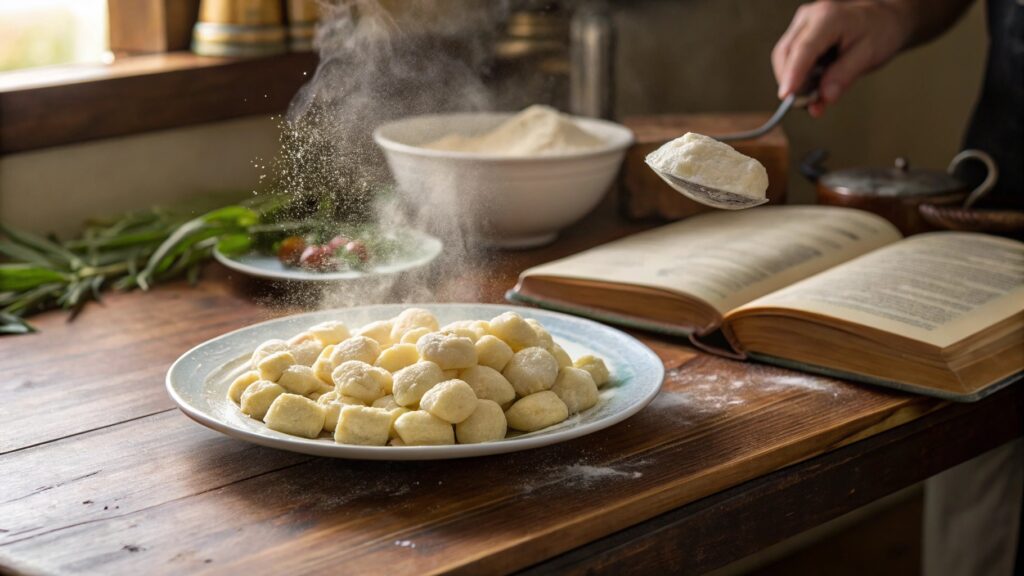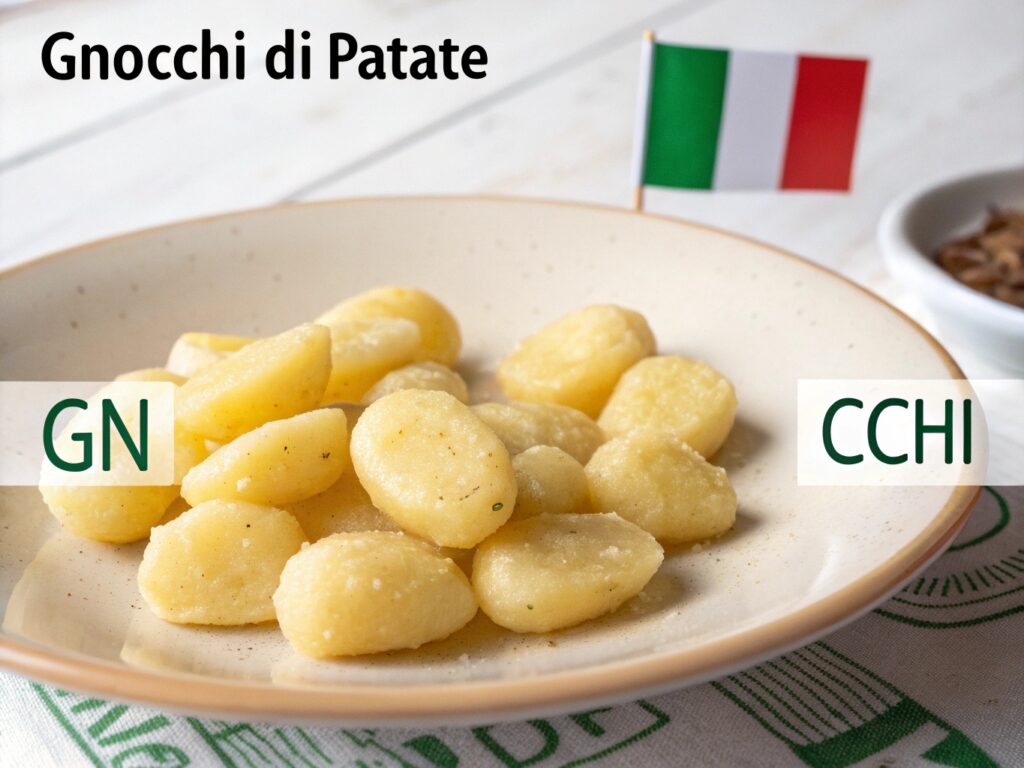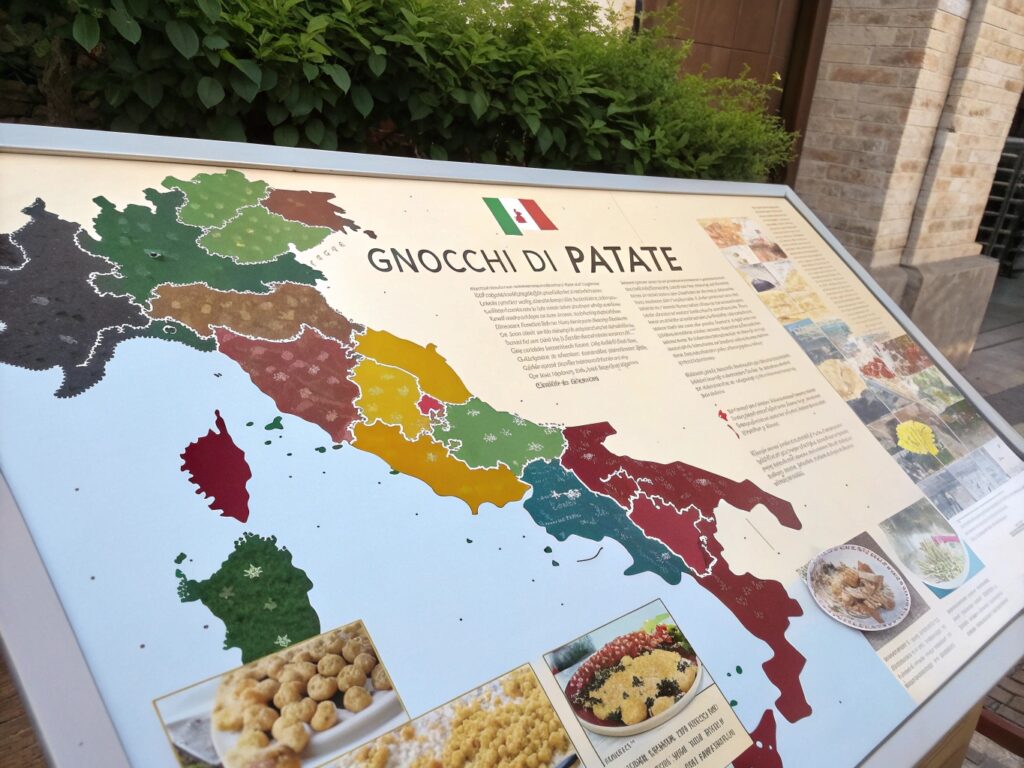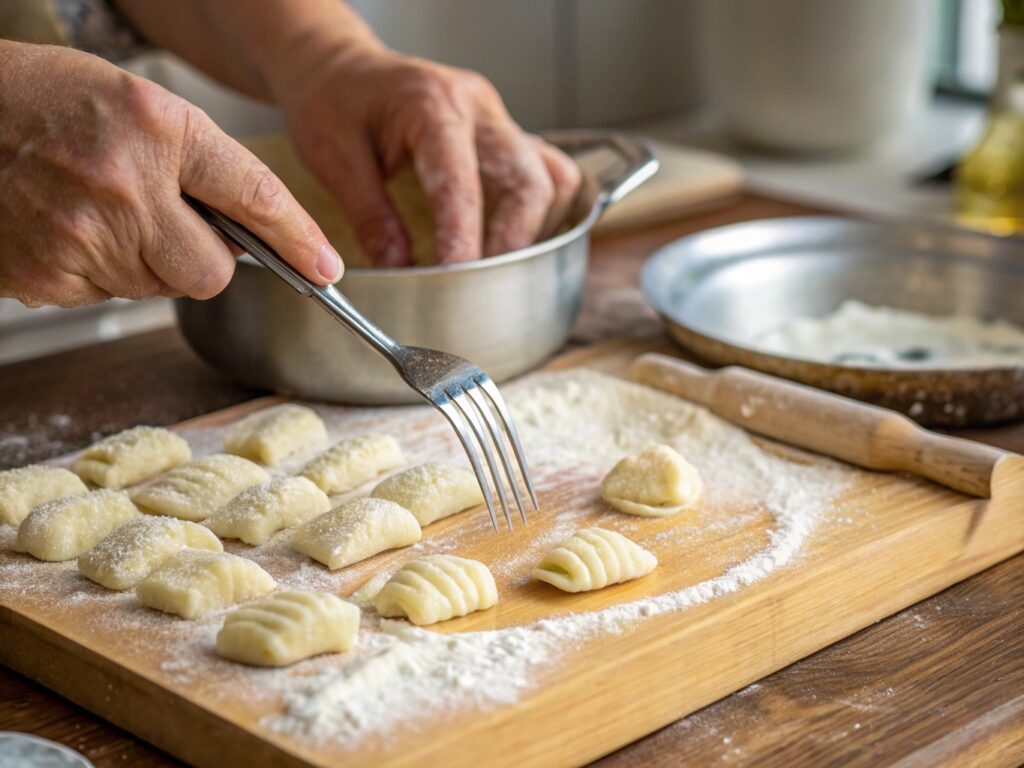How to pronounce gnocchi di patate? Say “nyoh‑kee dee pah‑TAH‑teh,” and you’ll sound effortlessly Italian at your next dinner party.
Imagine yourself in a lively Italian kitchen. The smell of new dishes is everywhere. You want to wow your friends with a real Italian meal, but you’re worried about saying “gnocchi di patate” right. Learning how to pronounce gnocchi di patate can seem hard, but mastering its pronunciation is key to truly enjoying Italian food.
If you love food or learning new languages, you’ll find gnocchi pronunciation fascinating. It’s not just about saying words; it’s about diving into Italian culture. This guide will help you feel more confident when talking about Italian food.

Understanding Italian Potato Gnocchi
Potato gnocchi are a beloved part of traditional Italian cuisine, but have you ever wondered, is gnocchi a potato or a pasta? Many people debate its classification, as it combines elements of both. They connect generations through their simple yet delicious preparation. These soft, pillowy dumplings have deep roots in Italian culinary heritage, representing more than just a meal but a cultural experience.
Origins of Traditional Gnocchi
The history of gnocchi goes back to ancient Roman times. Early versions were made from semolina or breadcrumbs. Italian regions developed unique recipes, making potato gnocchi a staple of home cooking.
The introduction of potatoes in European cuisine during the 16th century changed this beloved dish.
Cultural Significance in Italian Cuisine
In Italian food culture, gnocchi hold a special place. Thursdays are traditionally designated as gnocchi day in many Italian households, showing the dish’s cultural importance. Each region has its own variation, reflecting local ingredients and cooking traditions.
Basic Ingredients and Preparation
Making authentic potato gnocchi requires precision and quality ingredients. A typical recipe includes:
- 500g cooked Russet potatoes
- 125-150g all-purpose flour
- 1 egg
- Salt to taste
The preparation involves carefully mixing ingredients to create light, delicate dumplings. These dumplings float elegantly in boiling water. Mastering potato gnocchi takes practice, skill, and a deep respect for traditional Italian cooking techniques.
Breaking Down the Pronunciation Components
Learning Italian phonetics is key to saying “gnocchi di patate” right. The sounds in this phrase need focus on certain pronunciation details. These details make Italian speech stand out.
The first step in how to pronounce gnocchi di patate correctly is to get the ‘gn’ sound right, as it is unique to the Italian language. In Italian, “gn” is a unique sound not found in English. It’s like saying “ny” in “canyon,” making a soft sound that glides well.
| Phonetic Component | Pronunciation Technique | English Approximation |
|---|---|---|
| “gn” sound | Palatal nasal sound | Similar to “ny” in “canyon” |
| “cch” sound | Hard consonant cluster | Like “k” with slight aspiration |
| Vowel pronunciation | Clear, pure vowel sounds | Short, crisp articulation |

Every syllable in “gnocchi di patate” needs clear pronunciation. It sounds like ‘NYOH-kee dee pah-TAH-teh,’ with emphasis on certain syllables. Work on the rhythm and flow to get the Italian sound right.
Getting these sounds right takes time and effort. Listen to native speakers, practice often, and don’t worry about mistakes. With regular practice, your pronunciation will get better.
How do you pronounce gnocchi di patate?
Learning to say gnocchi di patate in Italian can be tough for English speakers. If you’re curious about its exact meaning, check out what gnocchi di patate means in English for a deeper understanding of this traditional dish. It’s all about the sounds that make this dish’s name come to life. Getting these sounds right is key in how to pronounce gnocchi di patate accurately, ensuring you sound like a local when you order.
Proper Italian Pronunciation Guide
The word gnocchi is said as “nyoh-key” or “knee-oh-key”. The hard part is the “gn” sound, which is like the “ny” in “canyon”. For di patate, say “dee pah-TAH-teh”, focusing on the middle syllable.
Common Pronunciation Mistakes
Many people in the U.S. say gnocchi as “noh-chee” or “guh-noh-chee”. These mistakes come from different Italian dialects. But, native speakers will thank you for trying, even if you’re not perfect.
Regional Variations in Pronunciation
Pronunciation changes in different parts of Italy. In the North, it sounds different from the South. Places like Lombardy and Veneto have their own ways of saying it, adding flavor to the word.
Practice is the best way to get better at saying Italian words. Listen to native speakers and practice until it feels natural.
Audio Guide: Listen and Practice
Learning to say gnocchi di patate right needs lots of listening and practice. It’s more helpful when you use real sound recordings. These recordings show the correct way to say words.
When you practice, pay attention to the ‘gn’ sound and how the words flow. Italian speakers say “gnocchi” softly, which can be hard for English speakers.
Here are some tips to get better at saying words:
- Use online resources with audio clips
- Listen to native speakers many times
- Record yourself and compare
- Practice in short, focused sessions
The word “gnocchi” is spelled G-noc-chi. It’s hard to say, with a rating of 4 out of 5. There are two audio guides to help you.
Digital tools can make learning Italian fun. Some apps give you points for saying words right. Pick apps with clear, real audio.
Pro tip: Being consistent is important. Spend 10-15 minutes every day listening and practicing.
Mastering the ‘Gn’ Sound in Italian
Learning Italian consonants needs a lot of practice. One of the biggest challenges in how to pronounce gnocchi di patate is mastering the ‘gn’ sound, which is difficult for many English speakers. It’s key to understand the sounds of the language for real Italian talk.
Getting the Italian consonant sounds right takes focus and listening well. The ‘gn’ sound is a big challenge. It needs a special technique and practice to get it right.
Phonetic Breakdown
The ‘gn’ sound in Italian is like the ‘ny’ in “canyon”. It’s a sound made by pressing the tongue against the roof of the mouth. At the same time, air flows through the nose.
Similar Sounds in English
| Italian Sound | English Equivalent | Example |
|---|---|---|
| ‘Gn’ | ‘Ny’ | gnocchi = similar to “canyon” |
| Palatal Nasal | Soft ‘N’ sound | agna = like “onion” |
Practice Exercises
To get better at pronunciation, try these exercises:
- Repeat “gn” sounds slowly
- Practice with minimal pairs
- Listen to native Italian speakers
- Record yourself and compare
Regular practice will help you master this tricky sound. It will make your Italian better.
The Importance of Proper Stress and Syllables
Learning Italian word stress is key to getting pronunciation right. Many Italian words stress the second-to-last syllable. This creates a unique rhythm that’s vital for clear communication. Proper stress is crucial when learning how to pronounce gnocchi di patate correctly, ensuring a natural Italian rhythm.
In Italian, syllable pronunciation is more straightforward than in English. Vowels always sound the same, making it easier to learn. This helps you build confidence in speaking Italian by focusing on vowel sounds.
Italian Pronunciation Insights
| Pronunciation Aspect | Key Characteristic |
|---|---|
| Word Stress Pattern | 80-90% of words stressed on second-to-last syllable |
| Vowel Consistency | Each vowel maintains identical sound regardless of position |
| Pronunciation Exceptions | 10-15% of words deviate from standard stress rules |
Practice is the best way to master Italian word stress. Native speakers value your effort to speak their language. So, don’t hesitate to try. Focus on tricky combinations like “gn” in gnocchi, which can be tough but important.
Good pronunciation is more than just sounding correct. It’s about connecting with Italian culture and food. Every syllable you stress correctly brings you closer to true communication.
Recording and Self-Assessment Tools
Getting better at Italian pronunciation takes practice and honest self-checks. Today, there are many tools to help you track your progress. These tools are great for learning tricky words like gnocchi di patate.
Using Voice Recording Apps
Smartphone apps have amazing features for checking your pronunciation. Apps like Speechling and ELSA Speak let you record and analyze your Italian. They compare your voice to native speakers, showing you what to work on.
Getting Feedback from Native Speakers
Talking to native Italian speakers can really boost your skills. Sites like iTalki and Tandem let you practice with them. They can give you direct tips on how to improve your pronunciation.
Online Pronunciation Resources
There are lots of resources online to help you learn Italian. Sites like Forvo and YouTube channels focus on Italian pronunciation. They have huge collections of audio to practice with.
| Resource Type | Best Features | Recommended For |
|---|---|---|
| Mobile Apps | Real-time pronunciation analysis | Beginner to intermediate learners |
| Language Exchange Platforms | Direct native speaker interaction | Intermediate to advanced learners |
| Online Audio Libraries | Extensive pronunciation examples | All learning levels |
Remember, the key to improving your Italian pronunciation is regular practice. Use these tools often to get better and sound more like a native speaker.
Common Dialectal Variations
Italian dialects show a wide range of regional pronunciations, like in “gnocchi di patate”. Each region in Italy adds its own twist to how words are spoken. This creates a rich mix of language that goes beyond standard Italian.
In Northern Italy, places like Veneto and Friuli-Venezia Giulia have their own way of saying gnocchi. The gn sound can be softer or more pronounced, depending on local dialects. For example, Sardinian dialects have a unique way of saying potato-based dishes.
Sicilian and Calabrian dialects change vowel sounds, affecting how gnocchi di patate is pronounced. The rhythm and intonation vary greatly from one region to another. Coastal areas might stretch syllables, while mountain regions might speak more quickly.

| Region | Dialect Characteristic | Pronunciation Variation |
|---|---|---|
| Veneto | Soft consonant sounds | Slightly softened “gn” |
| Sardinia | Unique vowel emphasis | Distinct rhythmic pattern |
| Sicily | Vowel modification | Altered syllable stress |
Knowing about these regional language variations can make you appreciate Italian cuisine more. When you travel through Italy, you’ll hear how the same dish sounds different in each place. This shows the local culture’s unique identity.
Italian dialects influence not just pronunciation but also how gnocchi is prepared. For a delicious Tuscan-inspired dish, try this Slow Cooker Tuscan Chicken Meatballs & Gnocchi recipe, which perfectly highlights regional flavors.
Tips for Perfect Pronunciation
Mastering Italian pronunciation takes dedication and smart learning strategies. To improve your Italian speaking, try a few key techniques. Start by listening to authentic audio like podcasts, movies, and native speaker recordings.
Improving pronunciation begins with careful listening. Pay attention to sounds like the ‘gn’ in gnocchi. Practice mimicking native speakers, focusing on their rhythm and intonation. Remember, 75% of English speakers find foreign sounds hard, so be patient.
Technology can help with learning. Use apps and online resources with audio guides. Record yourself and compare with native speakers to spot areas to work on. Almost 55% of people worry about mispronouncing words, but practice builds confidence.
Here are some strategies for improving Italian pronunciation:
- Watch Italian cooking shows and repeat culinary terms
- Use language exchange platforms to get feedback from native speakers
- Practice daily, even if just for 10-15 minutes
Working hard on pronunciation will not only improve your language skills. It will also make you appreciate Italian food culture more. With regular practice, you’ll get better at saying words confidently and correctly.
FAQ
How did the Italians pronounce gnocchi?
In Italian, gnocchi is pronounced as “nyoh-kee” (IPA: /ˈɲɔk.ki/). The tricky part for English speakers is the “gn” sound, which is similar to the “ny” in the English word “canyon.” To pronounce it correctly, let your tongue press lightly against the roof of your mouth while making a soft nasal “ny” sound before smoothly transitioning into “oh-kee.”
Is the G in gnocchi silent?
Yes, the “G” in gnocchi is silent when pronounced in Italian. Instead of saying “guh-nocchi,” the correct pronunciation starts with a soft “ny” sound, making it “nyoh-kee.” This silent “G” rule applies to many Italian words where “gn” appears, such as gnomo (gnome) and gnocca (a slang word for beauty).
How do you pronounce gnocchi in American English?
In American English, there are variations in pronunciation. Some people say “noh-kee,” while others say “nyoh-kee,” which is closer to the authentic Italian pronunciation. Another common mispronunciation is “guh-nok-ee,” which includes an unnecessary hard “G” sound. While native Italians will appreciate an effort to pronounce it correctly, many Americans use a simplified version.
What does the Italian word “gnocchi” mean?
The word “gnocchi” comes from the Italian term “gnocco,” which means “lump” or “dumpling.” It refers to small, soft dough-based pieces often made from potatoes, flour, and eggs. The dish has origins dating back to ancient Roman times, when earlier versions were made from semolina or breadcrumbs before potatoes were introduced to Italy in the 16th century.
Why do different regions in Italy pronounce gnocchi differently?
Italy has many dialects, and pronunciation can vary based on the region. In Northern Italy, such as in Lombardy and Veneto, the “gn” sound might be softer, while in the South, like in Naples or Sicily, it may be slightly more pronounced or elongated. Each region puts its own linguistic “flavor” on words, much like they do with their cuisine!
Conclusion

Learning to say “gnocchi di patate” is more than just words. It’s a way to connect with Italian culture. Your hard work shows you truly value Italian language and traditions.
Getting better at pronunciation takes time and effort. Every try you make gets you closer to speaking like a native. It’s okay if you’re not perfect yet. What matters most is your enthusiasm and effort.
Keep exploring Italian language and food with curiosity. Your desire to learn makes words and dishes bridges between cultures. Enjoy the journey of discovering Italian food and language, one step at a time.
What you’ve learned is more than just saying “gnocchi di patate” right. You’ve entered a world of stories, diversity, and language that deepens your understanding of Italy. It’s not just about how you say something, but what it means.
